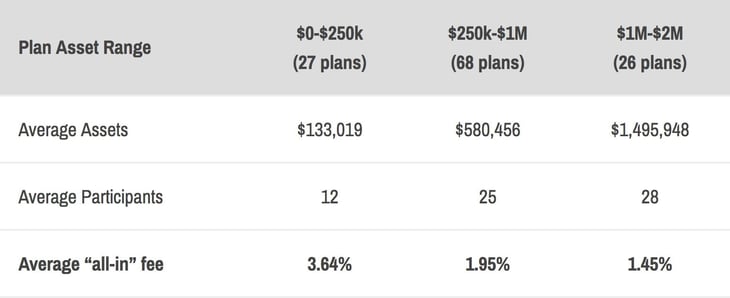If you're a 401(k) plan sponsor, you have a fiduciary responsibility to only pay reasonable plan fees and expenses from plan assets. Keeping 401(k) plan fees in check is one of your most important fiduciary responsibilities because even small excessive fee amounts each year can substantially reduce a participant nest egg over decades of saving. Excessive 401(k) fees can also mean severe consequences for you - including personal liability.
The problem? While this responsibility is clear, the definition of “reasonable” is not. ERISA does not define the word and government agencies only provide general guidance for evaluating 401(k) fees. The Department of Labor (DOL) suggests “establishing an objective process to aid in your decision making". This process should include an understanding of the fees and expenses you will pay and a review of those charges as they relate to the services to be provided and the investments you are considering.”
The consequences for paying excessive 401(k) fees are significant and real. You need an “objective process” to make sure your plan’s fees and expenses are both reasonable and in line with industry benchmarks. I advise comparing plan fees to the following benchmarks:
- Fees charged by other 401(k) providers
- Industry averages
If you follow these steps, it will become crystal clear whether your 401(k) fees are reasonable or if a plan provider change is in order. Regardless of the outcome, participant interests are protected and you’ve reduced your fiduciary liability. You should complete this analysis at least every 3 years – 401(k) fees are changing for the better all the time!
Benchmarking plan fees using other 401(k) providers
Benchmarking your plan’s fees and expenses using other 401(k) providers involves a two-step process:
- Calculate the “all-in” fee (service provider fees + investment expenses) for your plan
- Compare this fee to the all-in fee of 3 or more competing 401(k) providers
The key to making this process simple is using a 401(k) provider that charges only “direct” fees paid by employer invoice or participant account deduction. When a provider charges “indirect” fees paid from plan investments (e.g., revenue sharing or variable annuity wrap fees), their all-in fee may not be clear, making fee benchmarking impossible.
Benchmarking plan fees using industry averages
Unfortunately, benchmarking your 401(k) fees using industry averages can be difficult because publicly-available averages are practically non-existent. While the Form 5500 reports direct fees, it fails to report most indirect fees. This omission makes averages based on the Form 5500 – most notably, those used in online fee analyzers – unusable.
Our August 2016 small business 401(k) fee study can help. It includes all-in fees – sourced from ERISA 408b-2 fee disclosures – for 121 401(k) plans with less than $2M in assets. We found these plans paid an average all-in fee of 2.22% of plan assets. This average broke down as follows:

Make benchmarking simple - only hire 401(k) providers with transparent direct fees!
You don’t want to be surprised to find out your 401(k) plan is overpriced – the consequences for you and your employees can be too great. As our August 2016 study shows, 401(k) provider fees can vary dramatically – meaning it can be very easy pay too much.
To confirm your 401(k) plan’s fees are “reasonable,” you need to benchmark them periodically – I recommend at least every 3 years. This process basically involves comparing your 401(k) provider’s fees to other 401(k) providers and industry averages. The key to making this process simple is using a 401(k) provider that does not charge indirect fees paid by plan investments.

